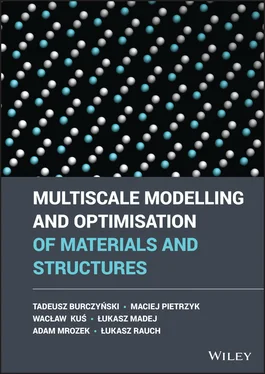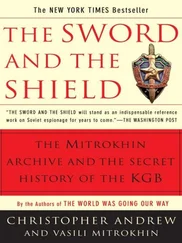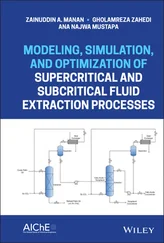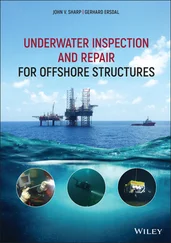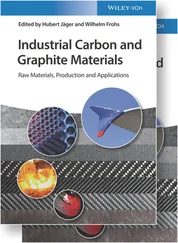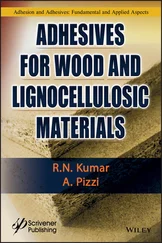X i,
X j) and final (
x i,
x j) positions of the...Figure 3.24 Assembly of the global system of equations:
M and
N denote bondi...Figure 3.25 The algorithm of solving the molecular statics problem.Figure 3.26 Shearing of the HCP lattice: (a) is the initial state; (b), (c),...Figure 3.27 Examples of cellular automata space division into (a) squares, (...Figure 3.28 Examples of (a)
n ×
n and (b)
n ×
m CA space composed of square ...Figure 3.29 Examples of CA neighbourhoods in the 2D space: (a) Moore and (b)...Figure 3.30 Examples of other types of CA neighbourhoods, (a) extended Moore...Figure 3.31 Examples of CA neighbourhoods in the 3D space: von Neumann and M...Figure 3.32 A 3D representation of random hexagonal neighbourhood.Figure 3.33 Cellular automata space is a random cellular automata method.Figure 3.34 Source of information for the definition of transition rules.Figure 3.35 Concept of the periodic boundary conditions with Moore neighbour...Figure 3.36 Example of
n ×
n MC computation domain with random assignment of...Figure 3.37 The examples of objective functions.Figure 3.38 The flowchart of descent algorithm.Figure 3.39 (a) Individual genes; (b) the flowchart of evolutionary algorith...Figure 3.40 Mechanism of simple crossover operator.Figure 3.41 Flowchart of the clonal algorithm, which is one of the artificia...Figure 3.42 Flowchart of particle swarm optimization.
4 Chapter 4Figure 4.1 Unit cells: (a) simple cubic, (b) body‐centred, (c) face‐centred,...Figure 4.2 Controlled cooling of the Al cluster: (a) unstable initial config...Figure 4.3 3D nanocrystalline structures of diameter approximately 20 nm obt...Figure 4.4 3D nanocrystalline structures obtained during fast (a) and slow (...Figure 4.5 Effects of fast and proper cooling: (a) amorphous phase and (b) H...Figure 4.6 The shape of the Morse potential functions for D e= 1 ev, r 0...Figure 4.7 2D nanocrystalline structures obtained for: (a) short ( α = 8...Figure 4.8 3D nanocrystalline structures obtained for various ranges of inte...Figure 4.9 3D nanocrystalline structures obtained for various ranges of inte...Figure 4.10 Squeezing of the set of 2D nanocrystalline structures: (a) initi...Figure 4.11 2D structures obtained during squeezing: (a) proper polycrystal;...Figure 4.12 The set of eight FCC balls: (a) general view; (b) cross‐section ...Figure 4.13 Obtained polycrystalline structure: (a) general view; (b) cross‐...Figure 4.14 Molecular model with (a) vacancies and (b) large voids.Figure 4.15 Molecular models used in tensile and shear tests: (a) ideal FCC ...Figure 4.16 Stress–strain curves – tensile test: (a) ideal FCC monocrystal; ...Figure 4.17 Stress–strain curves – shear test: (a) ideal FCC monocrystal; (b...Figure 4.18 Damaged structures during tensile and shear tests: (a) ideal FCC...Figure 4.19 Structure of the SLMoS 22H lattice.Figure 4.20 Stress–strain relations of the ideal SLMoS 22H lattice – (a) zig...Figure 4.21 SLMoS 2lattice before final failure: arrows indicate series of s...Figure 4.22 SLMoS 2lattices with different concentrations of vacancies.Figure 4.23 Illustration of (a) concept of the Delaunay triangulation steps ...Figure 4.24 2D digital material representation of polycrystalline microstruc...Figure 4.25 3D digital material representation of polycrystalline microstruc...Figure 4.26 3D digital material representation of periodic polycrystalline m...Figure 4.27 Examples of CA grain growth within the hexagon‐based discretizat...Figure 4.28 Subsequent stages of CA grain growth algorithm.Figure 4.29 CA grain growth results with different types of neighbourhoods: ...Figure 4.30 Digital microstructure with elongated grains obtained with the m...Figure 4.31 Digital microstructure with gradient grain size obtained with th...Figure 4.32 Digital microstructure with uniform grain distribution obtained ...Figure 4.33 Microstructure with 10 grains generated (a) without and (b) with...Figure 4.34 Results of microstructure with the substructure within the grain...Figure 4.35 Results of microstructure with the explicitly represented grain ...Figure 4.36 3D CA grain growth results with different types of neighbourhood...Figure 4.37 Digital microstructure models generated within various geometrie...Figure 4.38 Concept of the modified sphere growth algorithm.Figure 4.39 Results obtained in 3D space after subsequent steps of the algor...Figure 4.40 Result of modified sphere grown algorithm. The microstructure co...Figure 4.41 Illustration of the energy calculation process for (a) initial s...Figure 4.42 The Monte Carlo grain growth simulation with Q = 200, after (a) ...Figure 4.43 The process of grain growth in the 3D using the Monte Carlo algo...Figure 4.44 The Monte Carlo grain growth simulation for kT = 6, Q = 50; von ...Figure 4.45 A digital material representation model for the polycrystalline ...Figure 4.46 The use case diagram with basic functional requirements.Figure 4.47 Sequence diagram presenting the role of the wrapper in the appli...Figure 4.48 Neighbourhood classes and their relations.Figure 4.49 Original image of the microstructure from an optical microscope ...Figure 4.50 An original image from EBSD analysis and a reconstructed image o...Figure 4.51 An original image from optical microscopy and equivalent process...Figure 4.52 The histograms of various images of microstructures of the DP st...Figure 4.53 An original image of a two‐phase material with the result of ext...Figure 4.54 Flow stress models for different phases in steel [2, 15].
5 Chapter 5Figure 5.1 The idea of a distinction between upscaling models and concurrent...Figure 5.2 The idea of MS‐XFE scale decomposition.Figure 5.3 Division of domain applied by [53].Figure 5.4 Material division to non‐representative and representative atoms....Figure 5.5 Structure of the nanoscale–microscale model.Figure 5.6 Interfaces with (a) one subregion and (b) two subregions.Figure 5.7 The flowchart of solving the multiscale model.Figure 5.8 The BEM model with internal points.Figure 5.9 The plate with the rectangular notch: (a) continuum BEM model and...Figure 5.10 Continuum‐discrete model of the plate with the rectangular notch...Figure 5.11 Results of the simulation: (a) deformed plate and (b) close‐up o...Figure 5.12 The plate with the V‐notch: (a) continuum BEM model and (b) disc...Figure 5.13 Continuum‐discrete molecular model of the plate with the V‐notch...Figure 5.14 Results of the simulation: (a) deformed plate and (b) close‐up o...Figure 5.15 Separation of the atomic lattice from the BEM model.Figure 5.16 The plate with the U‐notch (a), and different types of an interf...Figure 5.17 Results of the simulation – close‐up of the deformed interior of...Figure 5.18 Convergence of the solution.Figure 5.19 The idea of the CAFE approach with the information flow between ...Figure 5.20 Schematic illustration of the CAFE model.Figure 5.21 Comparison of the frequency of the grain size obtained from the ...Figure 5.22 Geometrical representation of the obtained dual‐phase microstruc...Figure 5.23 CCT diagram obtained from measurements (filled symbols) and calc...Figure 5.24 Illustration of the developed multiscale strain localization CAF...Figure 5.25 Strain distribution predicted by the FE and CAFE models after th...
6 Chapter 6Figure 6.1 Average binding energies of the Morse clusters.Figure 6.2 The second difference of the binding energy of the Morse clusters...Figure 6.3 Average binding energies of the MM clusters.Figure 6.4 The second difference of the binding energy of the MM clusters.Figure 6.5 Super stable configurations of atoms: (a) tetrahedron N = 4, (b) ...Figure 6.6 N = 20 and N = 21 clusters.Figure 6.7 N = 29 Morse cluster.Figure 6.8 N = 9 structures: (a) global minimum of the Morse cluster ( E B= 0...Figure 6.9 Two‐dimensional, periodic carbon networks: (a) graphene, (b) grap...Figure 6.10 Structure of a chromosome.Figure 6.11 Block diagram of the memetic optimization algorithm.Figure 6.12 New carbon network X found by the optimization algorithm: (a) st...Figure 6.13 Progress of minimization of the total potential energy for the c...Figure 6.14 Stress–strain relation – horizontal direction for the carbon net...Figure 6.15 Stress–strain relation – vertical direction for the carbon netwo...Figure 6.16 New carbon network Y found by the optimization algorithm: (a) st...Figure 6.17 Progress of minimization of the total potential energy for carbo...Figure 6.18 Stress–strain relation – horizontal direction for the carbon net...Figure 6.19 Stress–strain relation – vertical direction for the carbon netwo...Figure 6.20 Multiscale optimization of a 2D structure: (a) the analyzed 2D b...Figure 6.21 The best result of optimization (a) after the first generation a...Figure 6.22 Elastic body with microstructure reinforcements: (a) model with ...Figure 6.23 Microstructure reinforcement modelled by means of NURBS.Figure 6.24 Microstructure (a) reference solution and (b) the best‐obtained ...Figure 6.25 Distribution of resultant displacements for the best solution of...Figure 6.26 The structure with local periodical microstructures.Figure 6.27 Microstructure with a circular inclusion with diameter d .Figure 6.28 Considered structure: (a) geometry with dimensions and (b) bound...Figure 6.29 Distribution of resultant displacements in the body after optimi...Figure 6.30 Sensors in (a) the real object and (b) the computational model....Figure 6.31 The considered model of the clamped rectangular shell: (a) macro...Figure 6.32 The macromodel (a) and micromodel (b) for the fibre’s shape iden...Figure 6.33 The results of identification.Figure 6.34 The objective function value versus the first design variable (w...Figure 6.35 The square plate made with a porous material: (a) macromodel und...Figure 6.36 Results of identification of voids in microstructures. Reference...Figure 6.37 Changes of identification functional values with respect to a nu...
Читать дальше
